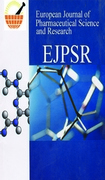Volume 2, Issue 1, 2015

Mcmed International
European Journal of Pharmaceutical Science and Research
Issn
XXX-XXXX (Print),
XXXX-XXXX (Online)
Frequency
bi-annual
Email
editorejpsr@mcmed.us












